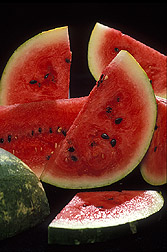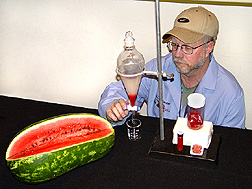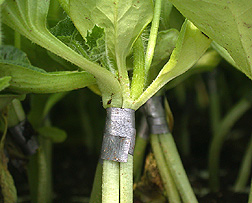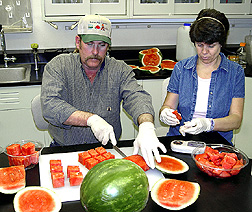Grafting Watermelon Onto Squash or Gourd Rootstock
Makes Firmer, Healthier Fruit
Perhaps nothing is so aptly named as the watermelon. This fruit (technically, it’s a vegetable, related to cucumbers, pumpkins, and squash) is actually 92 percent water. Once it is cut into chunks, watermelon can quickly become mushy. This presents a challenge to the fresh-cut market, which demands firm, attractive fruit. There’s a growing consumer demand for fresh-cut produce in the United States and around the world. These value-added products are found in most grocery stores, and shoppers love the ready-to-eat convenience.
Benny Bruton, a plant pathologist with the ARS South Central Agricultural Research Laboratory, in Lane, Oklahoma, evaluated watermelon tops grafted onto gourd and squash rootstock and confirmed them to be resistant to Fusarium wilt, a widespread and costly plant fungus. And grafting may also have solved the problem of mushy fresh-cut watermelon once and for all.
Watching Profits Wilt Away
Fusarium fungi live in the soil and attack plants at all stages of growth. If growers continually plant watermelons in the same soil, eventually they’ll wind up with a disease problem called Fusarium wilt. Until now, U.S. watermelon growers have dealt with Fusarium-infested soil in three ways: rotate the fields, treat with methyl bromide to kill the fungus, or grow resistant cultivars.
The first two solutions are becoming less workable; land is becoming less avail able for rotations, and methyl bromide is being discontinued due to environmental concerns. Watermelon cultivars are available with varying resistance to only two races of Fusarium, but grafted watermelons have resistance to all three races—and have the added benefit of firmness.
Grafting: An Old Practice With New Potential
|
|
In Japan, South Korea, and some European countries, watermelon producers haven’t had the luxury of rotating their crops from one field to another because their land resources are very limited. So, to get around the Fusarium wilt dilemma for the past 50 years, growers there have grafted their watermelon plants onto rootstock of squash, pumpkin, and gourd.
Bruton says that the U.S. watermelon industry previously did not embrace this grafting technique because it was considered too expensive, and producers had enough land that they could rotate from one plot to another.
In cooperation with Abbott & Cobb Seed Company, a national leader in the industry, Bruton and his colleagues evaluated watermelon tops grafted onto squash and gourd rootstock. Both cultivar and rootstock were carefully selected for the ideal combination, he says. Another industry partner, Speedling, Inc., performed the actual grafts at their nursery in Alamo, Texas.
|
|
Fruit Quality Increased
Bruton says that grafting watermelon plants onto other rootstock has been reported to produce inferior-quality fruit—though in other cases, no such effects were reported. What Bruton and his colleagues—Warren Roberts, a horticulturalist at Oklahoma State University’s Wes Watkins Agricultural Research and Extension Center (WWAREC) in Lane, and Wayne W. Fish, an ARS biochemist in Lane—have found, however, is that the fruit that comes from certain grafted plants is at least 25 to 30 percent firmer.
“And it has the added advantage of disease resistance to many soilborne pathogens as well as Fusarium wilt,” Bruton says.
Other ARS scientists have found that watermelon contains more of the health-promoting compound lycopene per serving than any other fresh fruit or vegetable. Lycopene gives watermelon and tomatoes their red color and is thought to act as a powerful antioxidant that may help to reduce the risk of age-related diseases.
Fish evaluated lycopene and sugar levels and says that the grafting technique doesn’t harm those characteristics. Firmer fruit could be a big plus for growers, because the fastest-growing niche market for watermelon (and cantaloupe) is the fresh-cut market. The fresh-cut industry is predicting that fresh-cut watermelon and cantaloupe will ultimately be an even bigger market than fresh-cut salads and vegetables. “Farmers should receive a high premium in return for a superior product,” Bruton says.
“Grafting isn’t going to be for everyone,” Bruton explains. “Producers have to evaluate their situation and see what will work best for them. Our evidence so far indicates we have a much firmer fruit, and firmness is one of the more important qualities for customer satisfaction.”
Economic Impact of Grafting
|
|
Growers recently spent as much as $350 per acre on methyl bromide treatments for Fusarium wilt control. WWAREC director and economist Merritt J. Taylor says that grafted transplants should be an affordable option for many producers once that cost is eliminated. Early results indicate that farmers may require fewer grafted plants per acre to produce the same yields and may need less fertilizer per acre, which should help control production costs.
Any new direction in agricultural production will require adjustments in practices. If grafting becomes popular in the United States, Roberts says, there will be a market for people who can perform the grafting operations under controlled environments and then ship the plants throughout the United States. He adds that there are many combinations of watermelon and squash, gourd, or pumpkin rootstock that still need to be evaluated for yield and quality.—By Jim Core, Agricultural Research Service Information Staff.
This research is part of Plant Diseases (#303) and Quality and Utilization of Agricultural Products (#306), two ARS National Programs described on the World Wide Web at www.nps.ars.usda.gov.
Benny Bruton is with the USDA-ARS South Central Agricultural Research Laboratory, Hwy. 3 West, Lane, OK 74555-0159; phone (580) 889-7395, fax (580) 889-5783.
"Grafting Watermelon Onto Squash or Gourd Rootstock Makes Firmer, Healthier Fruit" was published in the July 2005 issue of Agricultural Research magazine.










